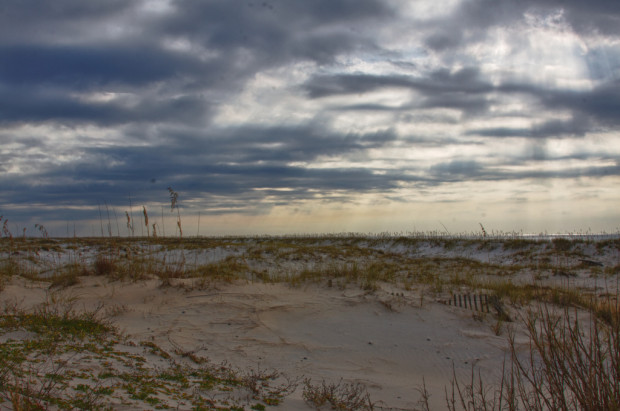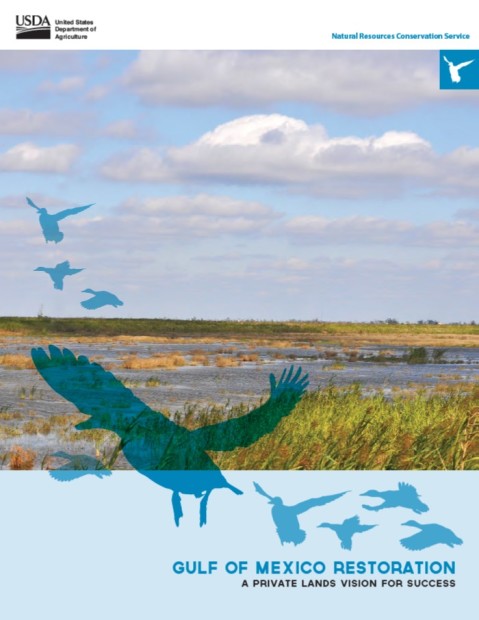We have much more to do and your continued support is needed now more than ever.
Private Lands and Gulf Restoration – A Vision for Success
The five US states bordering the Gulf of Mexico encompass roughly 290 million acres of land, of which roughly 86% are privately owned. This translates into more than 249 million acres of agricultural and forested lands, making it impossible to ignore when addressing any matter related to the conservation of our shared natural resources.
In order to help ensure private lands are considered in restoring the Gulf, the USDA’s Natural Resources Conservation Service (NRCS) recently released the report Gulf of Mexico Restoration: A Private Lands Vision for Success.
The Natural Resources Conservation Service feels that they are in a position to work with private landowners to improve the health of the Gulf of Mexico ecosystem, and they highlight several successes since the Deepwater Horizon disaster. An example critical to Gulf wildlife at the time of the spill was the Migratory Bird Habitat Initiative, which designated additional habitat on private lands for migrating shorebirds and waterfowl while oil was still billowing into the Gulf.
Landscape-Scale Conservation
In order to achieve comprehensive restoration, regardless of the geography, private lands must be made part of the overall equation for success. The Gulf of Mexico contains more than five million acres of coastal wetlands, of which more than half are privately owned. This should be taken into consideration by the Gulf Coast Ecosystem Restoration Council as they move forward with implementation of their Initial Comprehensive Plan, which calls for the restoration and conservation of key coastal habitats.
In order to help achieve these goals, the NRCS believes that a comprehensive private lands conservation strategy is essential to future success. As a result, they have recommended a multi-pronged approach, including restoring the health of rivers in all five Gulf States, increasing investments to restore and protect coastal habitats, expanding the Migratory Bird Habitat Initiative across all five Gulf States, and expanding the Mississippi River Basin Initiative to improve water quality and quantity. NRCS says that they are also prepared to begin immediate implementation of this vision.
Opportunities for Success
Funding related to the Deepwater Horizon oil disaster, including Natural Resource Damage Assessment, the RESTORE Act, and the Gulf Environmental Benefit Fund, have the potential to fund projects that aim to work with private landowners to protect and restore critical coastal ecosystems. Through a combination of conservation easements, which support wildlife habitat into the tufutre, and land acquisition, in cases where the land needs to be purchased in order to protect it into perpetuity, private landowners play an integral role in the long-term recovery and restoration of the Gulf of Mexico.
The following are provided as a few good examples for consideration:
Lower Suwannee River and Gulf Watershed – The Lower Suwannee National Wildlife Refuge includes one of the nation’s largest undeveloped river delta systems, and is one of its most productive. The Refuge is home to an abundance of wildlife, including numerous listed species; and its undisturbed salt marshes, tidal creeks, and flats provide foraging areas for thousands of shorebirds and waterfowl and are invaluable nurseries for fish, shrimp, shellfish, and juvenile sea turtles. The 46,500-acre Lower Suwannee River and Gulf Watershed Conservation Easement project is a rare opportunity to protect an expansive tract of land in a critical location. Building on the success of the adjacent 31,962-acre California Lake easement, completed in 2001, this project is directly adjacent to both the Lower Suwannee National Wildlife Refuge and the Big Bend Wildlife Management Area, and will vastly expand the protected area along Florida’s “Nature Coast.”


Speak up for Restoration
The RESTORE Act, which sends money from BP’s Clean Water Act fines back to the five Gulf States, gives us the opportunity to move the needle on these critical habitats and improve habitats and water quality in the Gulf of Mexico.
![]() Ask the Secretary of Commerce to make sure that BP’s oil spill fines are dedicated to projects that will improve the health of the Gulf of Mexico for people and wildlife.
Ask the Secretary of Commerce to make sure that BP’s oil spill fines are dedicated to projects that will improve the health of the Gulf of Mexico for people and wildlife.























